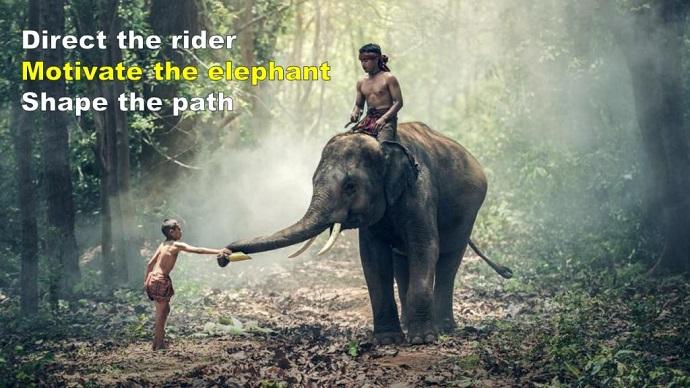The 'rider' or the 'elephant'?
We naturally think it's the 'rider', but the truth is this.
When push comes to shove, the elephant has a 6 tonne-advantage and wins every time!
Chris Dunn writes ...
As individuals and as teams, we embody both the 'rider' and the 'elephant'.
The 'rider' represents the logical, rational, thinking part of us.
We might even think of the 'rider' as the 'brain' that analyses, plans, and solves problems.
Whereas, the 'elephant', on the other hand, represents our emotions.
We might think of the 'elephant' as being more like our 'gut' or even that feeling part of us that inspires us to action and keeps us moving even when the going is tough.
How are the 'rider' and the 'elephant' relevant to an article about managing change?
The answer lies in understanding the way that change happens.
Change doesn't happen through logic alone.
No matter how hard our 'rider' pushes our 'elephant' to move in a new direction, it can stubbornly refuse to budge!
And even if our 'elephant' starts moving, it can quickly come to an abrupt halt when it faces an unexpected obstacle in our 'path'.
So how do we align our 'rider', our 'elephant', and our 'path' in order to make change happen?
In their book "Switch: How to Change Things When the Change is Hard", Dan and Chip Heath set out these 3 steps:
1. Direct the rider
2. Motivate the elephant
3. Shape the path
Directions to the 'rider' come in the form of a clear action plan. It's our logic-based transformation strategy.
Motivating the 'elephant' is done by tapping into our emotions and getting people excited about the prospect of change.
Vision, values, constant communication, and skillful storytelling are all critically important motivational elements.
Shaping the 'path' is all about breaking our transformation journey into manageable stages and, wherever possible, removing obstacles in our way.
And of course, focusing on the 'gain' (i.e., 'the progress so far'), rather than the 'gap' (i.e., 'what's still to do').
For help with change management, simply book your free online consultation through the Chris Dunn Consulting website.


